Contributory members are able to log private notes and comments about each site
Sites Anne T has logged. View this log as a table or view the most recent logs from everyone
Money Hill (Pickhill)
Trip No.23 Entry No.3 Date Added: 16th May 2017
Site Type: Artificial Mound
Country: England (Yorkshire (North))
Visited: Yes on 11th May 2017. My rating: Condition 2 Ambience 3 Access 5
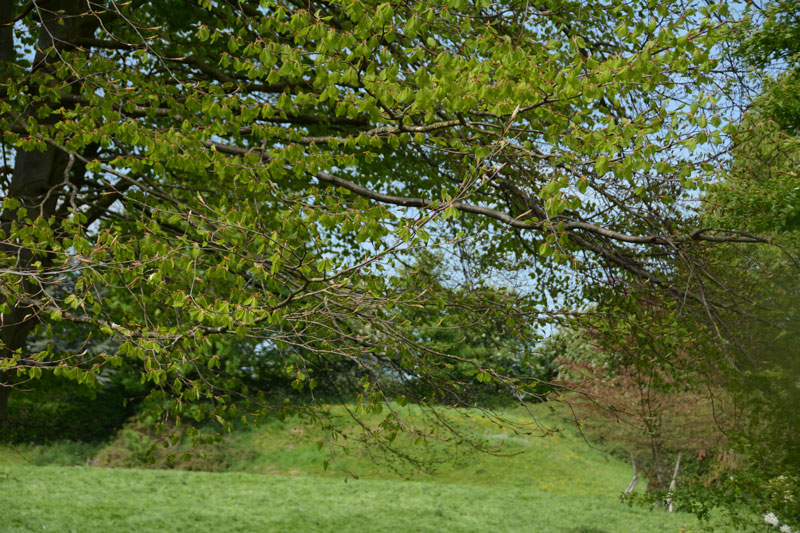
Money Hill (Pickhill) submitted by Anne T on 16th May 2017. The south eastern side of the motte rises about 3 metres high. Without the mentions on the OS map and the All Saints church guide, I would have driven straight past this scheduled ancient monument!
(View photo, vote or add a comment)
Log Text: Money Hill Motte, Pickhill: Leaving All Saints, going back down Money Hill to Street Lane, we stopped to look at the remains of the motte. I confess that without the grid reference and the OS map, I would have mistaken this for just another earthwork.
This is in fact a scheduled ancient monument, which was cut be the old railway line and the building of a bungalow. It is unusual in that it is square in shape.
Didn’t stop to wander round, as we were late for our appointment at St. Thomas’s, Brompton.
St Thomas (Brompton)
Trip No.23 Entry No.4 Date Added: 16th May 2017
Site Type: Ancient Cross
Country: England (Yorkshire (North))
Visited: Yes on 11th May 2017. My rating: Condition 4 Ambience 4 Access 5

St Thomas (Brompton) submitted by Anne T on 16th May 2017. These three hogbacks are truly magnificent. Having been buried in the ground for so long, they look as if they have been carved recently. Well worth a visit just to see these, never mind the other cross fragments.
(View photo, vote or add a comment)
Log Text: Hogbacks and Crosses, Brompton, North Yorkshire: This is a visit I’d arranged some time ago, arranging to meet the church warden at 2pm on 11th May (details on the 'A Church Near You' website). The church is kept locked, as we found out when we’d tried to visit a couple of years ago, and I was much looking forward to this return visit.
We were a little late, having stopped to photograph the remains of the motte at Pickill, and having hit a little traffic in Northallerton, but we found the church wardens sweeping up cherry blossom from the porch of the church. We were certainly made very welcome.
There are three complete hogbacks, the carving of which is very crisp, almost as if they had been done yesterday – preserved after having been buried in the ground for so long.
A further two fragments sit, almost hidden, against the north eastern corner of the nave, wedged between an altar, some heating pipes and the wall.
Sitting to the south of these, against the boundary between the nave and the chancel, was a wheel head cross. Another cross sat on the south wall of the chancel, with a further 3 sitting on the southern window ledge of the western wall.
The Cock Shaft sits almost hidden at the back of the pews, in the south west corner of the church, and is named so because there are three cocks on the southern face.
To my surprise, Doreen said there were three further fragments in the external south and east walls of the church, so we hunted for these whilst she spoke to the man repairing the churchyard wall. There are also the remains of a grave marker, now broken in two, placed in separate parts high up on the eastern wall.
We were given the ‘Village Trail’ and also told much interesting history about the linen factories in the village, and started off on the walk to see the village green, Cockpit Hill and the water splash. A great day out.
Torphichen Churchyard Stone
Trip No.24 Entry No.1 Date Added: 15th May 2017
Site Type: Standing Stone (Menhir)
Country: Scotland (West Lothian)
Visited: Yes on 13th May 2017. My rating: Condition 3 Ambience 4 Access 5
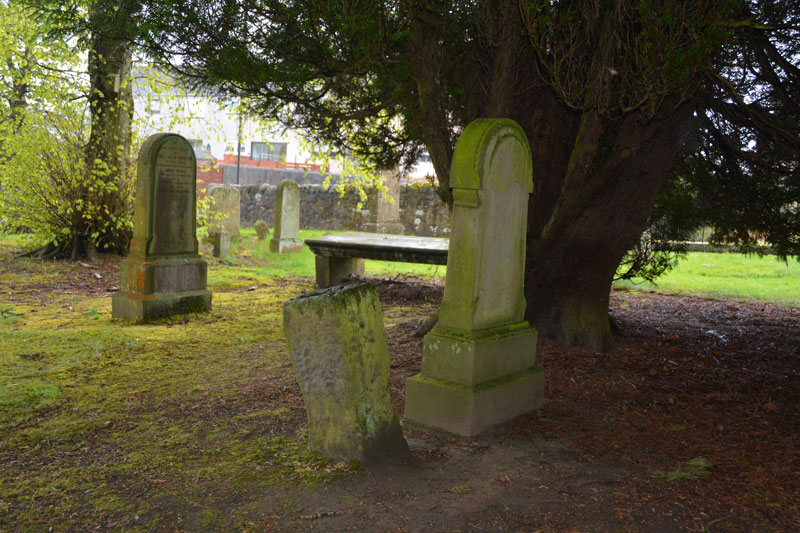
Torphichen Churchyard Stone submitted by Anne T on 15th May 2017. The Sanctuary stone sits in the part of the churchyard nearest to the road, tucked under a big yew tree and very near a modern grave marker.
(View photo, vote or add a comment)
Log Text: Torphichen Sanctuary Stone, West Lothian: After an exciting day at the filming of Robot Wars yesterday we stayed overnight at daughter and son-in-law's nearby. Torphichen is a lovely little village (Cairnpapple is also signposted further on from here), larger than I expected. The parish church incorporates/is next to the Preceptory of the Knights Hospitaller of the Order of St John of Jerusalem, which dates from the late 12th century.
The sanctuary stone is in the front of the churchyard (to the left of the gate as you enter, sheltering under a yew tree). There are other boundary stone markers around the area, and I really wanted to go and find these (the Canmore record says that they ‘once sat t a mile radius on each point of the compass. Of which the Gormyre Stone to the east-north-east and the Westfield stone survive’) but we had other priorities for the day. Another visit, probably in September/October.
There were some really interesting tombstones, particularly at the east end of the church – little people/heads/bones. Had some fun photographing these.
The Preceptory wasn’t open until 1pm on the day of our visit, so we missed it. Peering through a grill into the structure, it looked absolutely fascinating. Andrew discovered what looked like a well (similar to the Galilee Well at Durham Cathedral) against the east wall of the church, although I haven’t found any mention of it on any of the historical records (yet) although Canmore says there are 2 wells in the village, one of which supplied the Preceptory.
Torwood Broch
Trip No.24 Entry No.2 Date Added: 16th May 2017
Site Type: Broch or Nuraghe
Country: Scotland (Falkirk)
Visited: Yes on 13th May 2017. My rating: Condition 3 Ambience 4 Access 4
Torwood Broch submitted by cosmic on 23rd Sep 2005. View across broch to internal room.
(View photo, vote or add a comment)
Log Text: Tappoch/Torwood Broch, West Lothian: I’d wanted to go in search of the 2 boundary stones near Torphinchen, but was over-ruled in favour of the broch at Tappoch. By the time we’d left Torphinchen, the rain really started to come down, but being equipped with waterproofs, and supposedly sheltered by the tall forest trees, we set off anyway.
Parking on Glen Road, close to the footpath, we set off up the public right of way to Denoven (the car park that is mentioned in the main page is now a new house), then took the path which headed off right and up hill into the forest. It was lovely, soft spongy ground to walk on, with all the pine needles forming a soft covering over the prolific bedrock slabs.
Continuing up the hillside, the rain got heavier, but as we reached the broch, the rain stopped for a short period (just long enough for us to explore the broch).
The easiest way to access the interior of the broch is to take the path to your left, walking round the exterior wall of the broch. An internal staircase comes into view, and it’s easy walking down these few steps. Going straight up the hill was definitely for mountain goats! The interior feels roomy and solid, with sturdy, dry stone walls.
The foresters (or others) have clearly been using this structure, as there were the remains of a stone fire pit and recently burnt wood.
Looking closer at the lumps and bumps around the broch, I think there are other structures attached to this site. There was a very steep drop on the broch’s southern side, clearly excellent for defences.
Well worth a visit, even if it took several hours to dry out afterwards!
Cross Well (Linlithgow)
Trip No.24 Entry No.3 Date Added: 16th May 2017
Site Type: Holy Well or Sacred Spring
Country: Scotland (West Lothian)
Visited: Yes on 13th May 2017. My rating: Condition 3 Ambience 3 Access 5
Cross Well (Linlithgow) submitted by KiwiBetsy on 17th Oct 2006. Site in West Lothian
The present Cross Well stands in the High street of Linlithgow just outside the lane that leads to Linlithgow Palace.
(View photo, vote or add a comment)
Log Text: Cross Well, Linlithgow: This was our last stop on this rainy day, and we arrived to find a small market around the well, along with an event happening at the Burgh Halls immediately behind it. Couldn’t really get close to the well itself until later in the afternoon, as there were lots of stallholders, children and dogs. Truly a centre point for the town. No water in the well today – the spout and basin were completely dry. I confess I was disappointed to find such a modern structure - I'd expected something a lot older and less ornate.
We tried to find the Dogwell, walking up Dog Well Wynd as far as the railway line, but nothing.
After photographing the well as best I could, we wandered around the loch, then back round via St. Michael’s church, with its internal walls marked by musket balls and sword sharpening marks from Cromwell’s soldiers.
Cairnpapple Hill
Trip No.25 Entry No.1 Date Added: 21st May 2017
Site Type: Round Cairn
Country: Scotland (West Lothian)
Visited: Yes on 18th May 2017. My rating: Condition 3 Ambience 4 Access 4
Cairnpapple Hill submitted by ModernExplorers on 27th Mar 2013. A mound surrounded by smaller stones with holes, surrounded by a ditch and then more holes
(View photo, vote or add a comment)
Log Text: Cairnpapple Hill, West Lothian: Our first stop of the day, and I was really excited to visit this site after what I’ve read about it. We pulled up in the layby at NS 98968 71832 and made our way up the steps to the grassy field in which the cairn sits. My first reaction was ‘wow, look at those views – what a place to be buried’. The friend I was with told me we could see for 17-20 miles north and east.
At first, the mast in the farm nearby seemed to encroach upon the whole of the site, but as our visit progressed, I completely forgot it was there. The door to the Nissen hut was open, so I walked in clutching my ‘English Heritage’ cards to pay and buy a guide book from the gentleman inside. But, he told us he was an electrician, just there to carry out some tests; if the keys he had let us into the burial chamber proper, he would let us in. We followed him up the steps to the top of the mound, but sadly his keys wouldn’t open the black metal doors. What a shame!
We did, however, spent about an hour walking about the cairn (I was really disappointed to find out the dome was a modern construction, built to protect the burials), trying to understand it’s layout and the various stages of construction.
The interpretation boards said that the timber circle holes were filled with gravel, although there were others filled with grey/light brown gravel that were much bigger. I joked with my friend that the larger holes were big enough for crouch burials, so in fun, he demonstrated, with his mobile phone and glasses as his grave goods.
We could see the modern Knock Stone Circle in the distance. We said we’d go back with my friend and his wife when the visitor centre was open (Friday to Monday during summer months); she was brought up in the vicinity and knows the site well.
Knock Stone Circle
Trip No.25 Entry No.2 Date Added: 21st May 2017
Site Type: Modern Stone Circle etc
Country: Scotland (West Lothian)
Visited: Yes on 18th May 2017. My rating: Condition 4 Ambience 4 Access 5
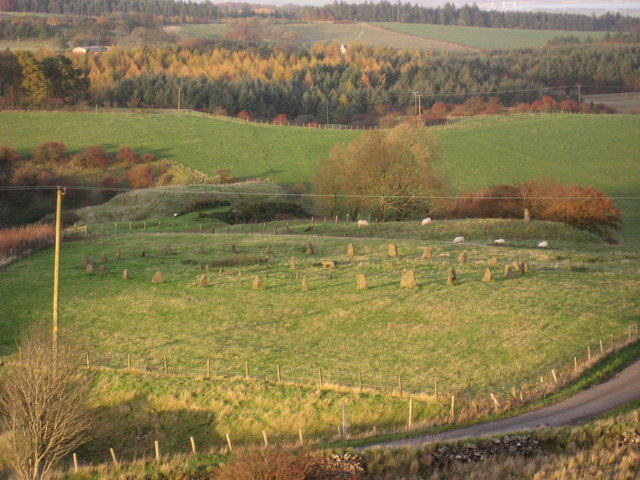
Knock Stone Circle submitted by Andy B on 12th Mar 2011. A faux stone circle, located by Knock in the Bathgate Hills, 2 miles (3 km) northeast of Bathgate in West Lothian. Comprising 50 stones, arranged in two concentric circles in a field by the roadside, the circle was built as a 50th Birthday surprise for the farmer by his son in 1998 and was undoubtedly inspired by the nearby Neolithic site at Cairnpapple Hill.
Copyright Chris Martin and licensed for reuse under this Creative Commons Licence.
(View photo, vote or add a comment)
Log Text: Knock Modern Stone Circle, West Lothian: Having passed this stone circle on the way to Cairnpapple, it looked impressive and I couldn’t wait to get back for a closer look. “Is this what a real stone circle looks like?” my friend (who is a relatively novice Megalith-hunter) asked. I chuckled as I read out the description from the Portal page which I’d printed off before I left home
It certainly looks as if it’s been here longer than 20 years!
The field was full of enormous sheep. The farmer has kindly built a small stile into the fence by the gate, which allowed us access into the field. We wandered round taking photographs. I really liked the little stone ‘seat’ in the inner ring, which the sheep gathered round.
I walked over to the outlier, which sits on a mound to the north-east of the circle.
On our way out, a car pulled out, parking half an inch from the bumper of our car. Out popped a photographer with a really big lens on his camera. He wandered up and down the road by the fence, taking photographs. We told him he could get into the field, either through the gate or over the stile. He said ‘thanks, but I’m waiting to get photos without the sheep’. As there were around 50 or so sheep in the field, I’m guessing he might have had some time to wait.
We headed off to Torphinchen for a snack and to visit the Preceptory (which was closed, even though the sign said it should have been open).
Cross Well (Linlithgow)
Trip No.25 Entry No.3 Date Added: 21st May 2017
Site Type: Holy Well or Sacred Spring
Country: Scotland (West Lothian)
Visited: Yes on 18th May 2017. My rating: Condition 4 Ambience 3 Access 5
Cross Well (Linlithgow) submitted by KiwiBetsy on 17th Oct 2006. Site in West Lothian
The present Cross Well stands in the High street of Linlithgow just outside the lane that leads to Linlithgow Palace.
(View photo, vote or add a comment)
Log Text: Cross Well, Linlithgow: From the Knock Modern Stone Circle, we set off towards the Gogar Stone. Passing through Linlithgow (we plan on going to see the Palace and nearby Hopetoun House) another day.
There was no market today, so I persuaded my friend to quickly stop which I got a proper photograph of the well! (Note the friend's car hiding behind the structure!)
Gogar Stone
Trip No.25 Entry No.4 Date Added: 21st May 2017
Site Type: Standing Stone (Menhir)
Country: Scotland (Midlothian)
Visited: Saw from a distance on 18th May 2017. My rating: Ambience 3 Access 4

Gogar Stone submitted by Andy B on 13th Mar 2010. Standing stone at Gogar
Copyright M J Richardson and licensed for reuse under the Creative Commons Licence.
(View photo, vote or add a comment)
Log Text: The Gogar Stone, West Lothian: This stone was conveniently located on our way back into Edinburgh, although we were only able to see it from a distance. Sited towards southern edge of a huge field, about 300 metres south east of East Norton Farm, access to the field can be gained from Freelands Road through the large gaps in the hedge which runs to the northern side of the road.
At the time of our visit, a crop of wheat was almost knee high in the field. We walked along the crop-free area of the field running alongside Freelands Road side, seeking a tractor track we could walk along to reach the stone. Not finding this, we turned and walked north, following the edge of the field along Gogarstone Road. Again, no track. I started trying to place my feet carefully between the densely planted rows of wheat without damaging them, but even my feet were too large to fit sideways inside the rows; it took me five minutes to get some 20 rows in, and only 1/10th way there!
I could have kept walking round this enormous field, but time was running short. We decided to come back once the crop had been harvested, and moved on to the Physic Well in Corstophine.
Physic Well (Corstorphine)
Trip No.25 Entry No.5 Date Added: 21st May 2017
Site Type: Holy Well or Sacred Spring
Country: Scotland (Midlothian)
Visited: Yes on 18th May 2017. My rating: Condition 3 Ambience 4 Access 5

Physic Well (Corstorphine) submitted by feorag on 31st Aug 2006. The overgrown remains of the Physic Well, Corstorphine. Photographed 23rd October 2005.
(View photo, vote or add a comment)
Log Text: The Physic Well, Corstophine, Edinburgh: Pulling up on the northern section of Dunsmuir Court from Ladywell Road, I thought we’d spotted the well head under the trees between the houses and the main road, but this turned out to be a milestone!
Thankfully having the image of the well from the Portal, we followed the Court round to the garden at the back, and found the well behind a black metal railing which looked as if it had been painted recently.
The area between the houses has been turned into a modern garden, with tall stones looking like standing stones between the plants.
A lovely little spot, a little oasis away from the busy Edinburgh roads not far away. The blocks of flats here are being renovated and the area has a bright, airy feel. Shame there was no water in the well, though, especially as it used to be such a tourist attraction in the past.
Walwick Fell
Trip No.26 Entry No.1 Date Added: 22nd May 2017
Site Type: Ancient Village or Settlement
Country: England (Northumberland)
Visited: Yes on 21st May 2017. My rating: Condition 2 Ambience 4 Access 4

Walwick Fell submitted by Anne T on 22nd May 2017. Looking over at the two banks to the south west of the main structure.
(View photo, vote or add a comment)
Log Text: Walwick Fell Farmstead, near Hexham: This settlement is not far from Tower Tye, where the Tynedale North of the Wall Archaeology Group used to meet before the surveys. Turning south on the un-named road towards Whinney Hill, we parked in a small layby at the edge of the wood on the east side of the road, opposite the gate into the field containing the settlement. The footpath runs diagonally north west across the field, with the settlement to the right hand side towards the top of the hill, but with bullocks grazing in the field, looking very interested in coming over to us, we gave them a wide berth and approached the settlement from the east.
The settlement appears as a series of defined banks on the slope of the hill, with gorse bushes to its south-western side.
In the wood behind the stone wall to the north of this settlement lies the remains of a Roman camp, but it has been so disturbed by forestry works it is not really possible to see anything.
There are the clear remains of two hut circles, with their foundations built into the back of the slope. The banks are all turf covered and easy to make out. The site has wonderful views to the west, south and east (south to the South Tyne Valley), although it is in a sheltered spot just below the brow of the hill.
Looking on UK Grid Finder when I got home, it is impressive how much of the site can be made out on the aerial image.
There is a well marked on the OS map in the lower part of the field, although it was not evident when we made our way back to the gate.
East Steel Farm
Trip No.27 Entry No.1 Date Added: 26th May 2017
Site Type: Modern Stone Circle etc
Country: England (Northumberland)
Visited: Yes on 25th May 2017. My rating: Condition 3 Ambience 3 Access 5

East Steel Farm submitted by Andy B on 24th Nov 2001. East Steel Farm Stone Circle
(View photo, vote or add a comment)
Log Text: East Steel Modern Stone Circle, Near Beltingham, Northumberland: From Beltingham, the further we drove out into the fells, we kept seeing bright yellow ‘Art Gallery Open’ signs. Long way to go for an art gallery, but a lovely drive. Note for future visitors – follow these signs!
As we pulled up to the lane leading down to East Steel House, marked by the signpost (see below), Dennis Kilgallon’s van was coming up to the road junction, signalling to turn right along the minor road. We indicated to go left and we passed each other. Parking by the circle, I hopped out with the camera, not realising Dennis had parked up and came across to speak to us. “Just taking a look?” he asked, “It’s a folly – built 10 years ago”. I thanked him kindly as he got back into his van and drove off. What a lovely place for an art gallery.
I counted 14 stones in the circle, most looking like reused gateposts, some of them leaning, largely built inside an old boundary, now just an arc of raised earth and stone in the ground topped in places by old, crooked, atmospheric hawthorn trees. Two of the stones were placed nearer to the track, outside the boundary - the circle wasn’t circular.
There was one really huge stone, presumably meant to be the heel stone. I wondered how it got there. My husband grunted and said “truck and crane probably.” At this point, a man in black was pelting up the track towards us, and I thought this was the farmer coming to warn us off, but no, it was a runner, who bid us good evening on his way past.
After 10 minutes or so appreciating the calls of the curlews on the surrounding fells, we headed off back to Beltingham and home.
St. Mungo's Well (Simonburn)
Trip No.27 Entry No.1 Date Added: 27th May 2017
Site Type: Holy Well or Sacred Spring
Country: England (Northumberland)
Visited: Yes on 25th May 2017. My rating: Condition 2 Ambience 2 Access 4
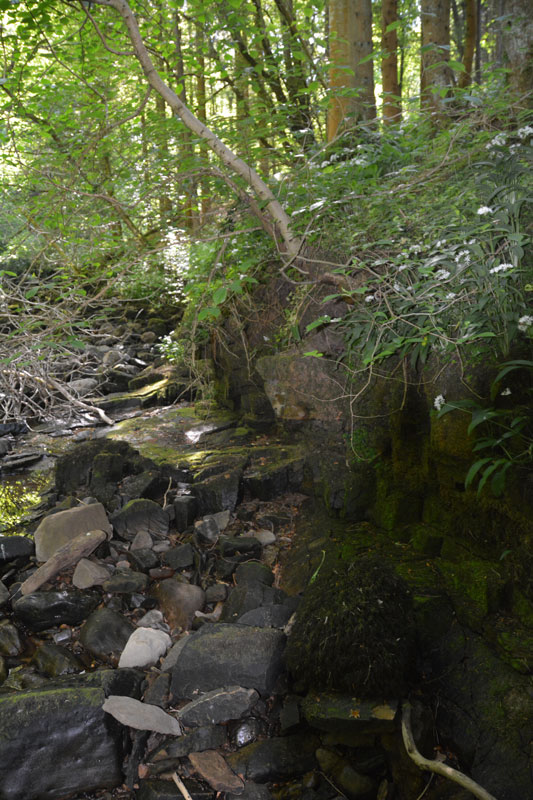
St. Mungo's Well (Simonburn) submitted by Anne T on 27th May 2017. This is the very tumbledown structure at the grid reference for the well. It hasn't been used for a very long time, and my husband wasn't convinced he'd found the right place, but it was the only structure that he could find around.
(View photo, vote or add a comment)
Log Text: St. Mungo's (Mugger's) Well, Simonburn: Our first stop on this hot, sunny day. Parking at Simonburn tea-rooms, we asked if it was OK to leave the car there whilst we walked round the village, and were told it was alright (there is another car park in between the south wall of the churchyard and the forest). I would thoroughly recommend sitting out in the tea-room gardens with a cup of tea and iced water, as they have very comfortable garden furniture and it’s a very quiet spot.
It was a relief to get into the cool of the forest leading down to the Crook Burn, which hardly had any water in it at all after so little rain for weeks and weeks. It was possible to walk on the stream bed.
Following the tracks through the forest to the burn, there is little or no sign of the well. There appears to be an flattened area which might represent an old path, running along the ledge at the top of the burn on its north side, but this has been long out of use. It’s also a three foot plus drop onto the bed of the burn at this point.
Lacking the confidence to walk along the large slippery blocks of stone along the stream bed, I handed the camera to my husband and went exploring the forest tracks. Andrew came back having seen the remains of a structure, long disused, at the grid point indicated for the well, so we are not entirely convinced this is it.
St Cuthbert's Well (Bellingham)
Trip No.27 Entry No.2 Date Added: 26th May 2017
Site Type: Holy Well or Sacred Spring
Country: England (Northumberland)
Visited: Yes on 25th May 2017. My rating: Condition 3 Ambience 4 Access 5
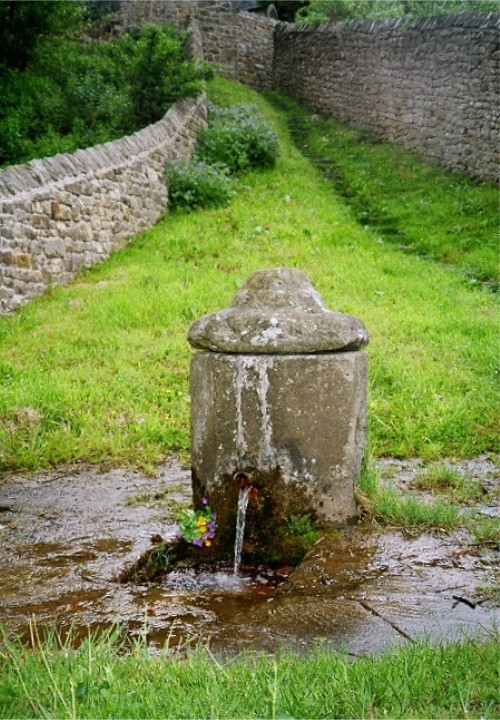
St Cuthbert's Well (Bellingham) submitted by KiwiBetsy on 11th Dec 2004. St Cuthbert, a noted dowser, found and dedicated this abundant spring of clear, pure water quite unlike the brackish marsh water of the area.
Today, the water is contained in a picturesque Georgian pant with it’s ever flowing spout directing the water down through a grill and away to the River Tyne. The upright pant was considered a vast improvement over the older dipping well provided water pressure justified building one.
The water is still used in the church for baptisms. The lo...
(View photo, vote or add a comment)
Log Text: Cuddy's Well (St. Cuthbert's Well, Bellingham): Parking in a small layby at NY 83833 83303, just opposite Manchester Square side road, we headed off to the church. The church was open, so we popped in to have a look. It looked relatively modern, but a plan hooked on the wall told us the sanctuary and chancel dated from the 13th century. Research this afternoon on British Listed Buildings said the church was extensively remodelled in 1609 and bell cote added in 1865. The stone barrelled roof was certainly interesting.
There was a marked grave ‘the lang pack’ in the churchyard, which the ‘A Church Near You’ website says is “the 'Long Pack' grave of a would be house-breaker who was killed by the butler of the house he was trying to rob.”
The well was mentioned briefly on the wooden plaque containing points of interest. To find this, we needed to go out of the church, walk south by the Black Bull, then turn right along the Pennine Way, following the eastern external wall of the churchyard. The path narrowed between two stone walls, but turning round a corner we encountered shallow steps leading down a bank, and there was the well at the bottom. We could hear water gushing from half way down the steps. The water rushed through the grill into the pool below, foaming up with the pressure. I did taste the water; it was fresh, but had no specific taste of any mineral.
On the eastern side of the current well structure there was another hole in the stone, and looked as if at some point either another spout came through, or the current spout had been moved.
Walking back up to the car, we noticed signs for the well and riverside walks from the main square (Manchester Square) in the town, which could be used for disabled access. I didn’t realise until I looked at UK Grid Reference Finder how close we had been to the North Tyne River, as the view was blocked by a very overgrown part of the cemetery.
Shitlington
Trip No.27 Entry No.4 Date Added: 27th May 2017
Site Type: Marker Stone
Country: England (Northumberland)
Visited: Yes on 25th May 2017. My rating: Condition 3 Ambience 4 Access 4
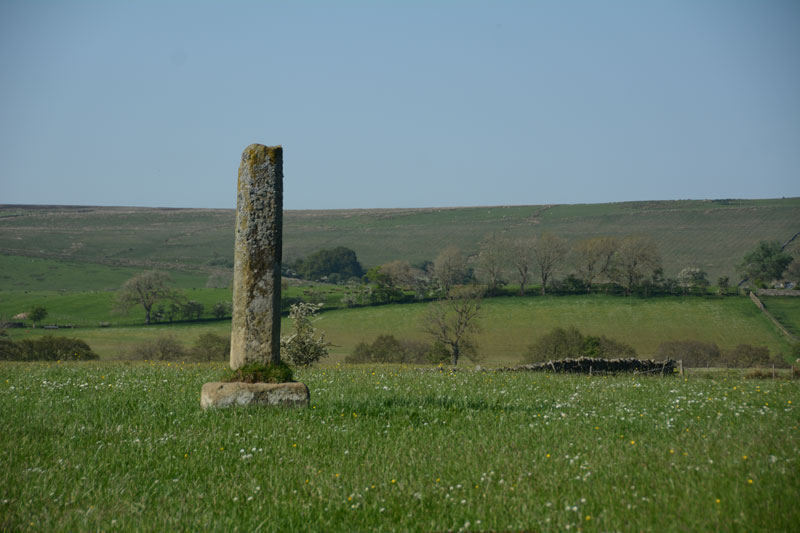
Shitlington submitted by Anne T on 27th May 2017. First view of the Shitlington Cross, walking across the field from the make-shift stile across the stone wall. The views across the surrounding moors are lovely.
(View photo, vote or add a comment)
Log Text: Shitlington Cross, near Bridge House (south of Bellingham): We stopped here because we were passing on the way to the Bridge House/Hetherington Farm homestead and it was marked on the OS map as a ‘cross’. It looks like an old standing stone on a sandstone cross base, similar to the Hurl Stone near Ewe Hill/Lilburn Grange (http://www.megalithic.co.uk/article.php?sid=35235but with a genuinely older base (not just reset in concrete).
Someone had made a stile over the wall into the field. As this was just pasture, we kept to the edge of the field to have a closer look. Very enigmatic, just sitting in the middle of the field with nothing around it.
Checked the top – there was no socket on top, just weathered. It was worth stopping to look because of the wonderful views over Watergate Moor, Wark Common and Broughy’s Hill. Could have sat here all day in the sunshine.
Bellshiel Law
Trip No.28 Entry No.1 Date Added: 29th May 2017
Site Type: Chambered Cairn
Country: England (Northumberland)
Visited: Yes on 28th May 2017. My rating: Condition 3 Ambience 5 Access 5
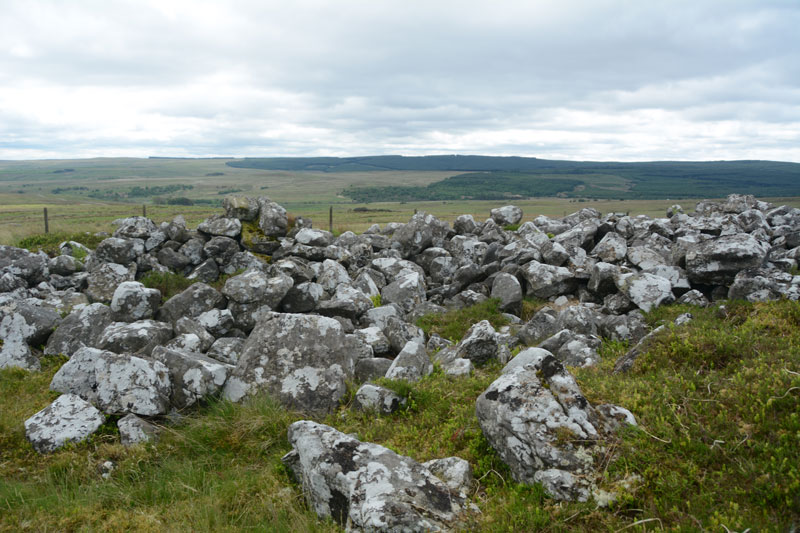
Bellshiel Law submitted by Anne T on 29th May 2017. The northern side of the cairn is partly earth and turf covered for the first few feet. Whether this is just build of earth through the prevailing wind blowing it in or the remains of a purpose built covering was difficult to tell.
(View photo, vote or add a comment)
Log Text: Bellshiel Law, Otterburn Ranges: It felt very strange driving onto the Otterburn Ranges with no red flags flying and no military around – I felt like I was trespassing. The ranges are absolutely huge – the Access map and Guide says they cover 90 square miles. We saw 3 other cars all day, 2 of those from a long distance, and 3 cyclists.
Bellshiel Law can be reached by a military road approx. 2 km on the western side of Rochester. The start to this road system is quite complex, but we headed left and left again taking us up over Bellshiel Road. AT NT 81079 01161 the road forks. At this point take the right hand fork. The cairn comes into view on the right hand side of the road. There is a small parking area underneath a natural crag at NT 81267 01260. My first reaction was “Wow, this is huge”.
Narrow trackways through the grass lead you to the cairn, which is fenced off and labelled “Archaeological Area” and “Out of bounds to Troops”. A gate (difficult to open with all the marren grass around it, but managed to squeeze through) lets you into the cairn. It is large – Pastscape recording it as 367 feet long and 52 feet wide at its eastern end, with a maximum height of 6ft (1932 measurements), which translates to 109m long, varying in width from 8.8m at the west end to 15m at the broader east end, maximum height of 1.6m (1994 English Heritage Scheduling).
Someone has built a sheep pen on the southern side, presumably using stones from the cairn. Walking along the stones at the side of the cairn, largely turf covered, I spotted a number of circular ‘rooms’ inside the cairn, with one oblong shape. Called a long cairn by Pastscape, they record “the cairn on the whole, was found to contain no structural remains of an earlier period (ie cists, chambers, revetments internal structures ….. and cannot be dated any earlier than Early Bronze Age and possibly later.”
Great views to the south to the River North Tyne Valley and beyond.
Inner Golden Pot (Otterburn)
Trip No.28 Entry No.2 Date Added: 29th May 2017
Site Type: Marker Stone
Country: England (Northumberland)
Visited: Yes on 28th May 2017. My rating: Condition -1 Ambience 4 Access 5
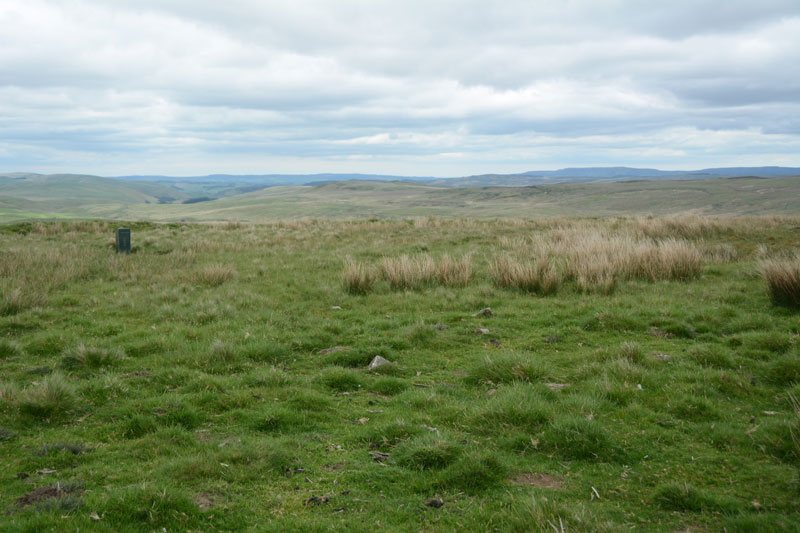
Inner Golden Pot (Otterburn) submitted by Anne T on 29th May 2017. At the site of the Inner Golden Pot there were only broken sandstone pieces and modern army equipment. I thought it was worth stopping to look to see if anything remained, especially as it was a nice viewpoint.
(View photo, vote or add a comment)
Log Text: Inner Golden Pot, Otterburn Ranges: No trace of this cross base can be found, but I couldn't resist having a look. There were some small sandstone pieces around the grid reference point, together with a funny green box - presumably some military equipment. A great viewpoint across to Upper Coquetdale.
Middle Golden Pot (Otterburn)
Trip No.28 Entry No.3 Date Added: 29th May 2017
Site Type: Marker Stone
Country: England (Northumberland)
Visited: Yes on 28th May 2017. My rating: Condition 2 Ambience 4 Access 5
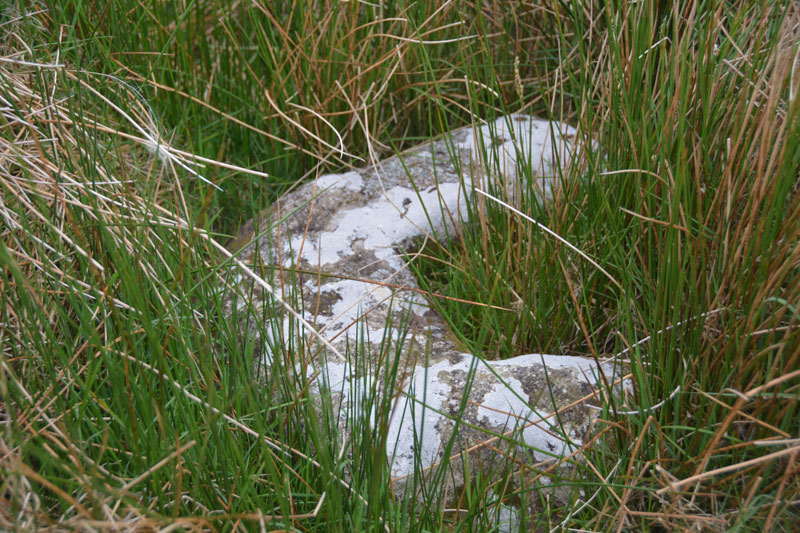
Middle Golden Pot (Otterburn) submitted by Anne T on 29th May 2017. The Middle Golden Pot from a different angle.
(View photo, vote or add a comment)
Log Text: Middle Golden Pot (Otterburn): Fenced off behind a nice, neat fence with a label “Do not feed the cross base” – no seriously, “Archaeological Area”. This stone was mostly hidden under the marsh grass and I struggled to get decent photographs as the camera kept focusing on the grass rather than the stone. Whilst I snapped away, Andrew went off wandering along the top of Dere Street off to the east – very well defined with a visible ditch on either side. The modern metalled road (imaginatively called ‘Roman Road’ turns a left-handed right angle here, as the course of Dere Street changes. Being just below the brow of a hill, I wondered why the stone was placed here, but looking at the change of direction of the road, it made sense. Stepping behind the stone and looking north-west, Dere Street could be seen running up hill, joining with the section to the east of the stone.
Outer Golden Pot (Otterburn)
Trip No.28 Entry No.4 Date Added: 29th May 2017
Site Type: Marker Stone
Country: England (Northumberland)
Visited: Yes on 28th May 2017. My rating: Condition 2 Ambience 4 Access 5
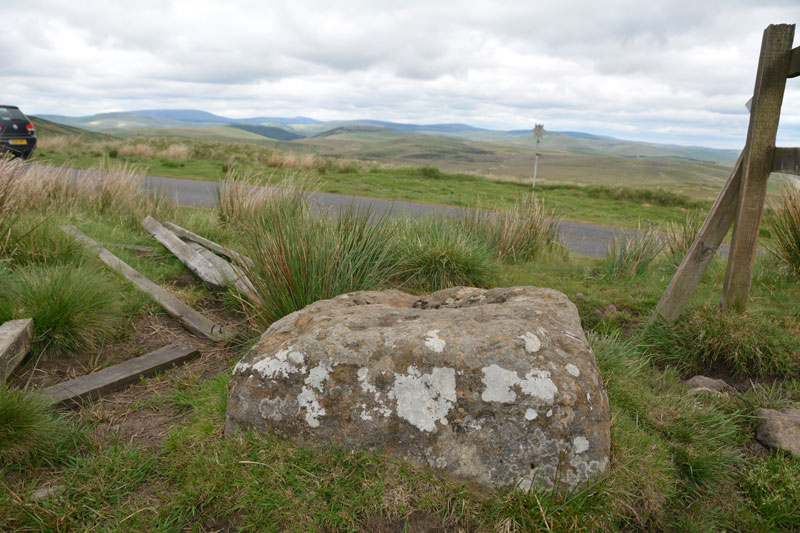
Outer Golden Pot (Otterburn) submitted by Anne T on 29th May 2017. From it's eastern side, the Outer Golden Pot has wonderful views over Upper Coquetdale.
(View photo, vote or add a comment)
Log Text: Outer Golden Pot (Otterburn): What stunning views across to Upper Coquetdale from here. No wonder the site is marked as a view point on the Otterburn Ranges Access Map. The fencing surrounding this Golden Pot has been broken on three sides, so it’s possible to appreciate its form more fully than the Middle Golden Pot.
The base is smaller than the Shitlington Cross but is about the same size as many of the Anglo Saxon Cross Bases we’ve seen in and around churches in North Yorkshire.
As I stepped back towards the road to photograph the base, I saw what looked like a cart track running diagonally up the hillside, crossing under the road and carrying on in a north-east/south-west direction. Andrew pointed out that if I moved a bit further over, I could see the second ditch, so this was the old course of Dere Street, now metalled and called ‘Roman Road’.
After stopping to photograph this stone, we went in search of Ridlees Cairn and Bushman’s Crag, to the south east of these intriguing cross bases.
Ridlees Cairn
Trip No.28 Entry No.5 Date Added: 29th May 2017
Site Type: Cairn
Country: England (Northumberland)
Visited: Yes on 28th May 2017. My rating: Condition 3 Ambience 4 Access 4
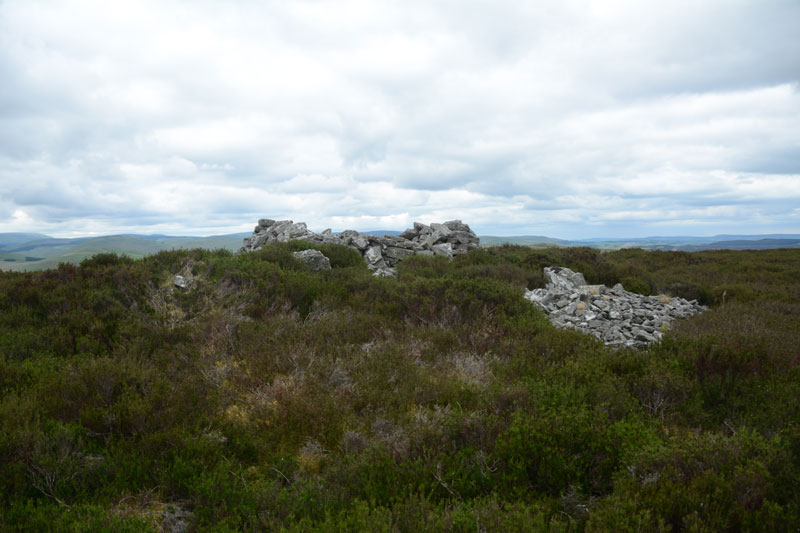
Ridlees Cairn submitted by Anne T on 29th May 2017. Approaching Ridlees Cairn from the east. It is a substantial cairn, made up of small and medium sized stones.
(View photo, vote or add a comment)
Log Text: Ridlees Cairn, Otterburn Ranges: This is one of the times I’ve actually made it up to a Trig Point (usually too steep a climb or too high a drop for my liking), but this was easy. Ridlees Cairn was actually 250 metres to the east north east of Bushman’s Crag, but I’m sure some people may visit the crag thinking it is the cairn. The views here are impressive. No wonder the military have a bunker hidden just up the road, and possibly hollowed out the centre of the cairn for use as a machine gun nest (apologies if this is not the case, this is just husband guessing).
Parking at the cairn (the metalled roads had deteriorated from this point and were very narrow), we walked to the east of the cairn and pushed through the heather to reach it.
It is substantial, with a flattened stone kerb around it, partly hidden by heather, partly by tumbled stones.
